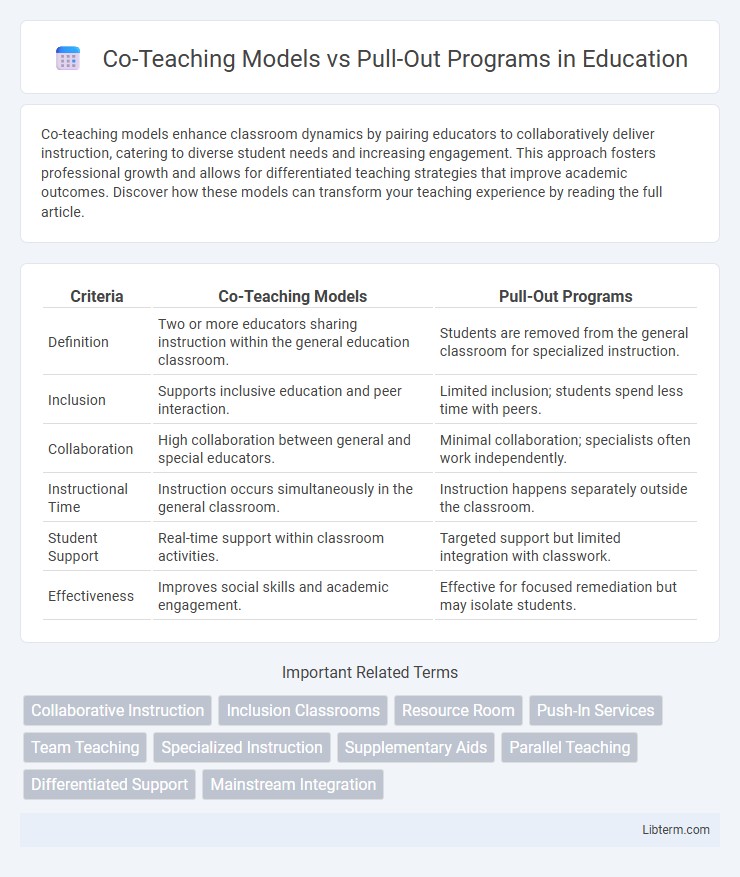Co-teaching models enhance classroom dynamics by pairing educators to collaboratively deliver instruction, catering to diverse student needs and increasing engagement. This approach fosters professional growth and allows for differentiated teaching strategies that improve academic outcomes. Discover how these models can transform your teaching experience by reading the full article.
Table of Comparison
| Criteria | Co-Teaching Models | Pull-Out Programs |
|---|---|---|
| Definition | Two or more educators sharing instruction within the general education classroom. | Students are removed from the general classroom for specialized instruction. |
| Inclusion | Supports inclusive education and peer interaction. | Limited inclusion; students spend less time with peers. |
| Collaboration | High collaboration between general and special educators. | Minimal collaboration; specialists often work independently. |
| Instructional Time | Instruction occurs simultaneously in the general classroom. | Instruction happens separately outside the classroom. |
| Student Support | Real-time support within classroom activities. | Targeted support but limited integration with classwork. |
| Effectiveness | Improves social skills and academic engagement. | Effective for focused remediation but may isolate students. |
Introduction to Inclusive Education Approaches
Co-teaching models in inclusive education involve general and special educators collaboratively delivering instruction within the same classroom, promoting differentiated learning and continuous support for all students. Pull-out programs isolate students with special needs for specialized instruction outside the general classroom, potentially limiting their access to mainstream social and academic experiences. Inclusive education favors co-teaching as it enhances student engagement, encourages diversity acceptance, and supports individualized learning within an integrated environment.
Defining Co-Teaching Models
Co-teaching models involve two educators, typically a general education teacher and a special education teacher, collaboratively delivering instruction within the same classroom to support diverse learners. These models include approaches such as team teaching, station teaching, parallel teaching, alternative teaching, and one teach-one assist, each designed to meet varied student needs through shared expertise. Unlike pull-out programs where students are removed from the general classroom for specialized instruction, co-teaching promotes inclusive education by embedding support directly into the regular classroom environment.
Understanding Pull-Out Programs
Pull-out programs involve removing students from their regular classrooms for specialized instruction in subjects like reading or math, providing targeted support tailored to individual learning needs. These programs often accommodate small groups or one-on-one settings, allowing educators to focus intensively on skill deficiencies or enrichment opportunities. Although effective for focused intervention, pull-out programs may limit social integration and reduce time spent with peers in general education environments.
Key Differences Between Co-Teaching and Pull-Out
Co-teaching models involve collaboration between general and special education teachers working simultaneously in the same classroom to support diverse learners, promoting inclusion and consistent engagement. Pull-out programs remove students from the general classroom for specialized instruction, often leading to less integration with peers and potential disruption in the regular curriculum. Key differences include the setting of instruction, degree of inclusion, and immediacy of support, with co-teaching fostering shared responsibility and pull-out emphasizing individualized remediation.
Academic Benefits: Co-Teaching vs Pull-Out
Co-teaching models promote inclusive learning environments by integrating general and special education teachers to support diverse student needs within the same classroom, enhancing peer interaction and collaboration. Pull-out programs isolate students for specialized instruction, which can provide targeted skill development but may limit access to the general curriculum and reduce social integration. Research shows co-teaching leads to improved academic outcomes by facilitating immediate support and differentiated teaching strategies, while pull-out programs often face challenges in maintaining curriculum continuity and engagement.
Social-Emotional Impact on Students
Co-teaching models foster inclusive classroom environments that enhance students' social-emotional development by promoting peer interaction and collaborative learning. Pull-out programs, while providing targeted academic support, may inadvertently isolate students, potentially impacting their sense of belonging and self-esteem. Research indicates that co-teaching supports emotional well-being better by integrating social skills development within everyday learning contexts.
Teacher Collaboration and Professional Development
Co-teaching models foster continuous teacher collaboration by enabling shared instructional planning, real-time support, and joint assessment, enhancing professional growth through sustained partnership. Pull-out programs often limit collaborative opportunities as educators work independently, reducing chances for co-planning and feedback exchange. Effective professional development in co-teaching emphasizes relationship building and instructional integration, leading to more cohesive and inclusive learning environments.
Classroom Management and Learning Environment
Co-teaching models enhance classroom management by fostering collaboration between general and special education teachers, creating a cohesive learning environment tailored to diverse student needs. In contrast, pull-out programs often disrupt the classroom dynamic, isolating students and potentially hindering social integration and consistent behavior expectations. Effective co-teaching promotes inclusive instruction and smoother transitions, improving engagement and reducing behavioral issues compared to pull-out interventions.
Student Outcomes and Success Metrics
Co-teaching models enhance student outcomes by promoting inclusive classrooms where general and special education teachers collaborate to address diverse learner needs, resulting in improved academic achievement and social integration. Pull-out programs often isolate students for specialized instruction, which may limit exposure to grade-level content and peer interaction, potentially impacting long-term success metrics such as standardized test scores and graduation rates. Data indicates co-teaching supports higher engagement, increased confidence, and better retention of knowledge compared to traditional pull-out methods.
Choosing the Right Model: Factors to Consider
Choosing the right instructional model involves evaluating student needs, available resources, and teacher expertise to determine if Co-Teaching Models or Pull-Out Programs offer better support. Co-Teaching Models promote inclusive learning and collaboration by integrating special education and general education teachers in the same classroom, enhancing accessibility for diverse learners. Pull-Out Programs provide targeted, individualized instruction but may limit exposure to the general curriculum and peer interactions, making them suitable when personalized attention outweighs integrative benefits.
Co-Teaching Models Infographic

 libterm.com
libterm.com